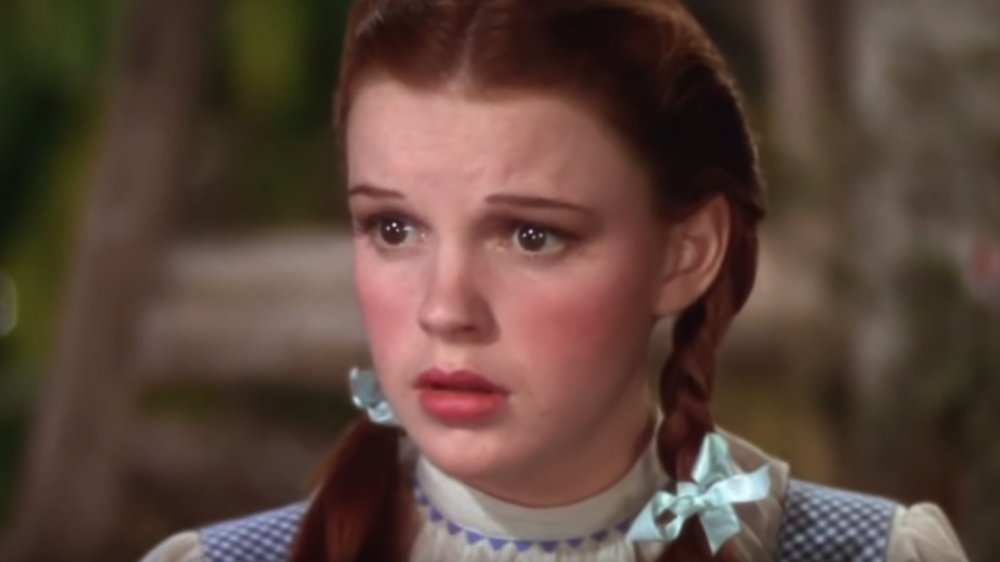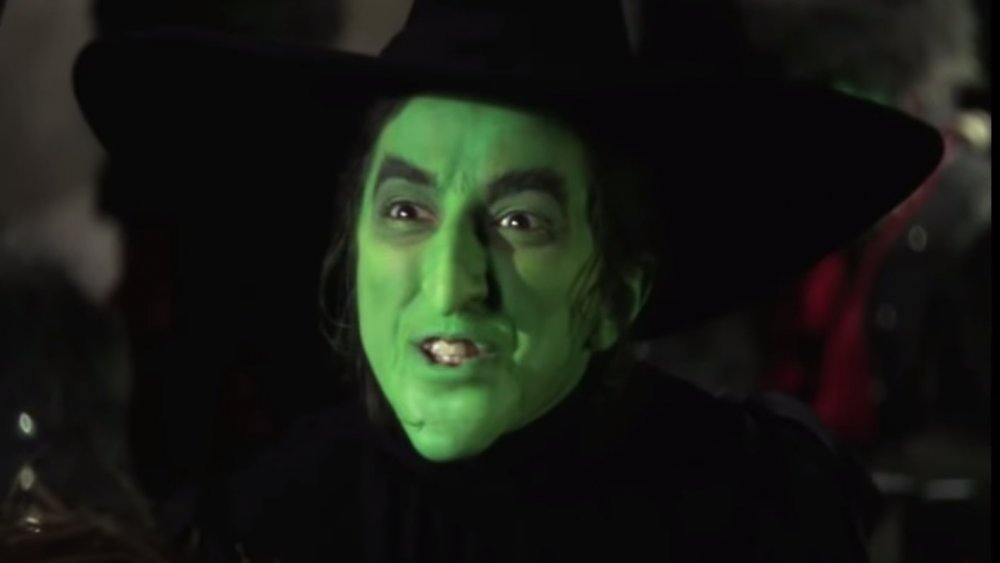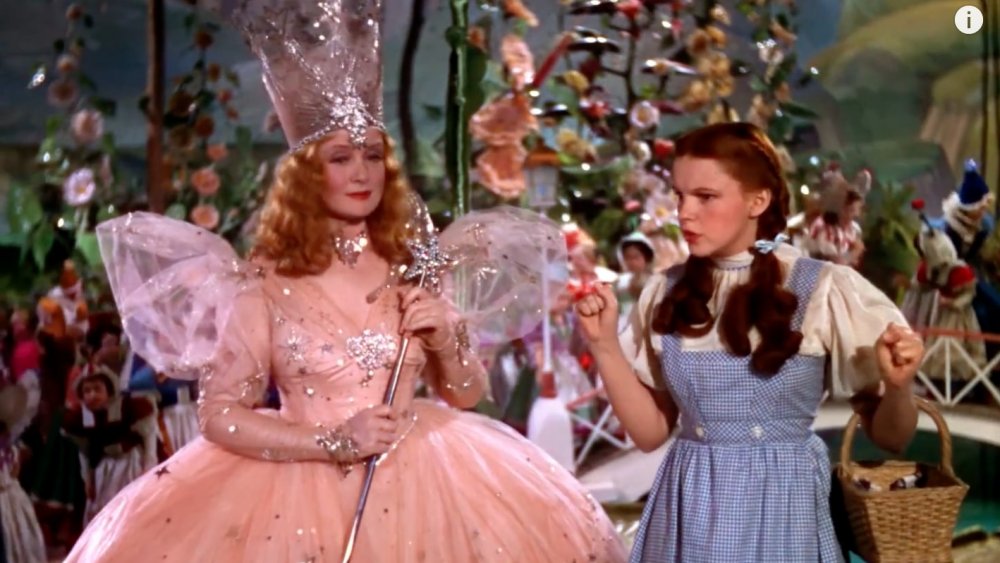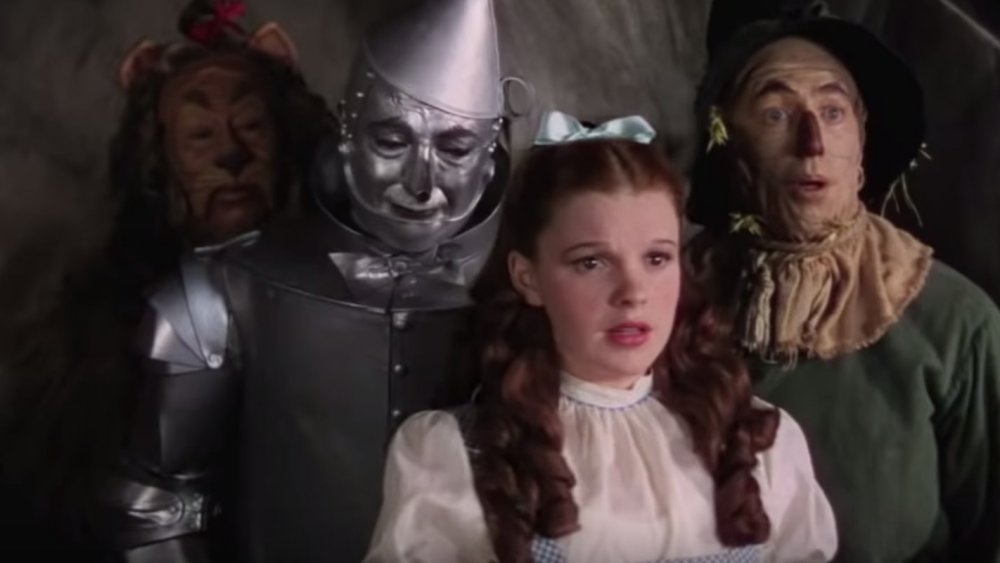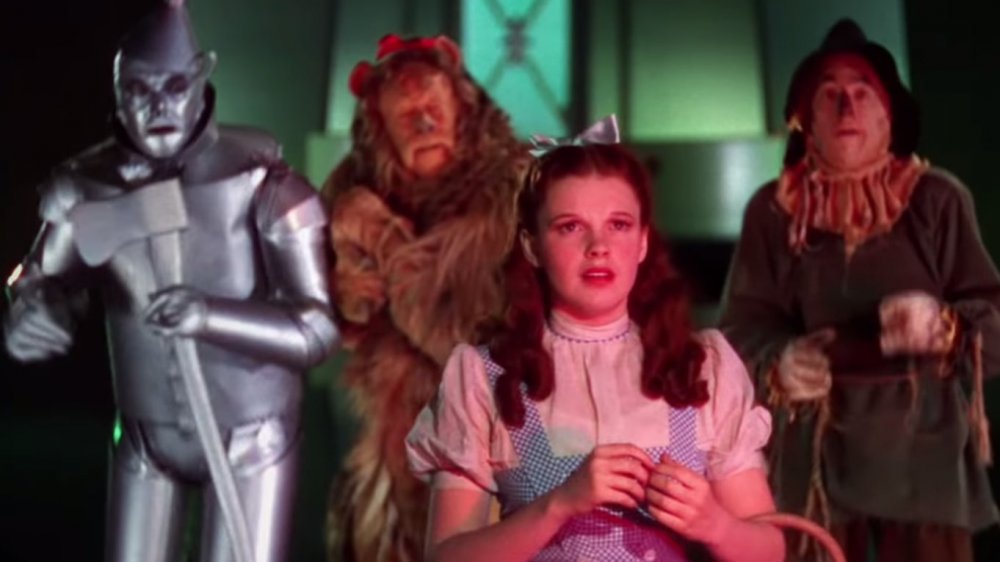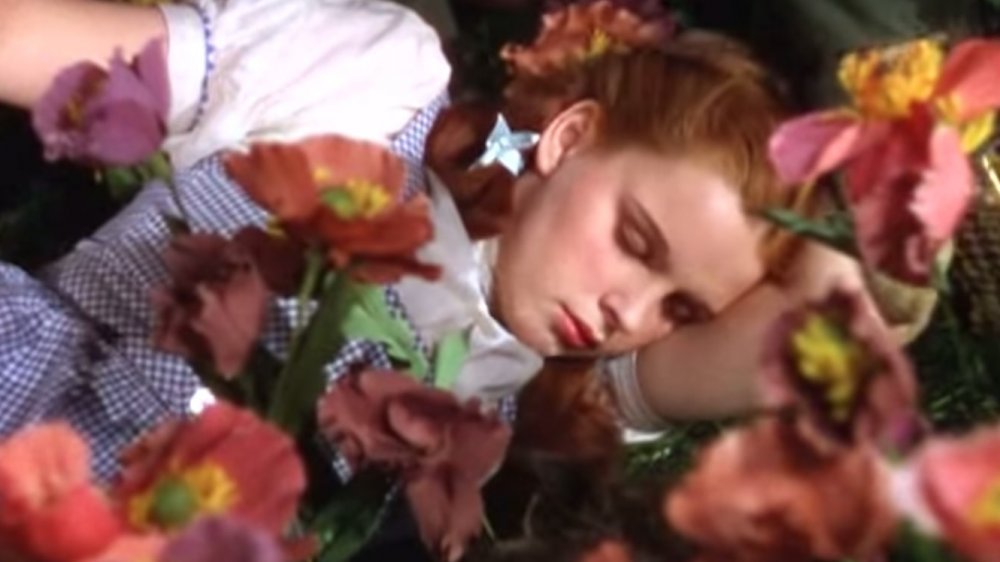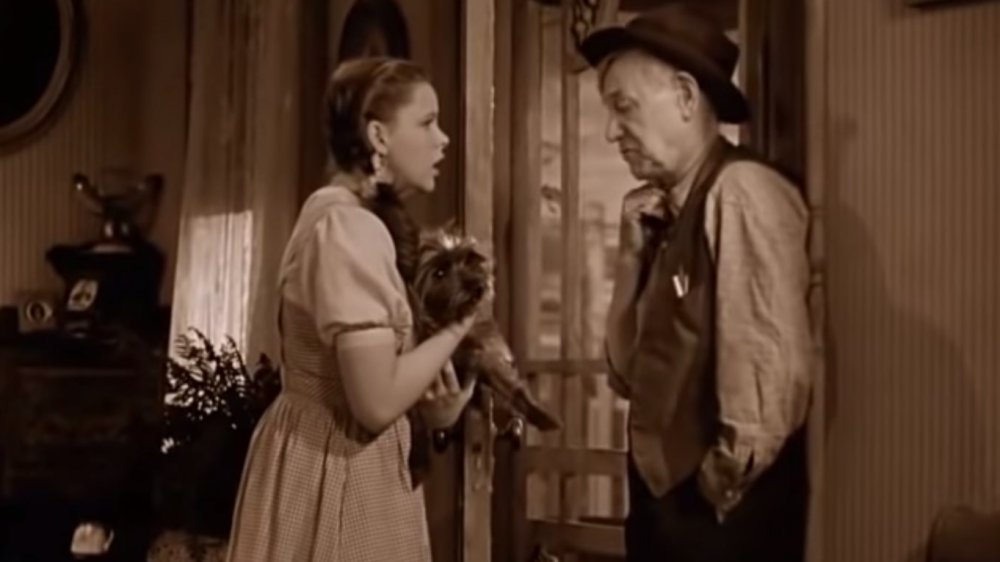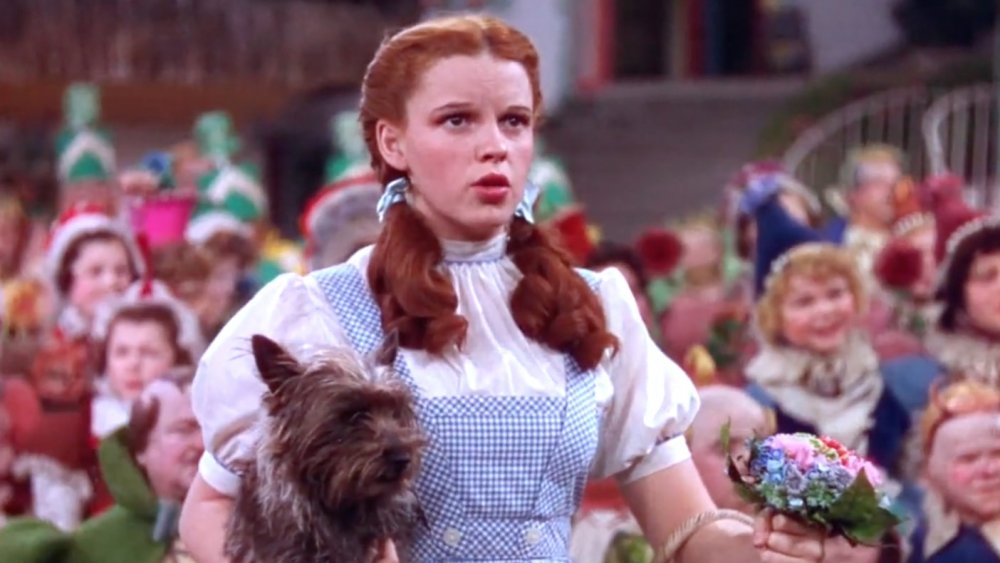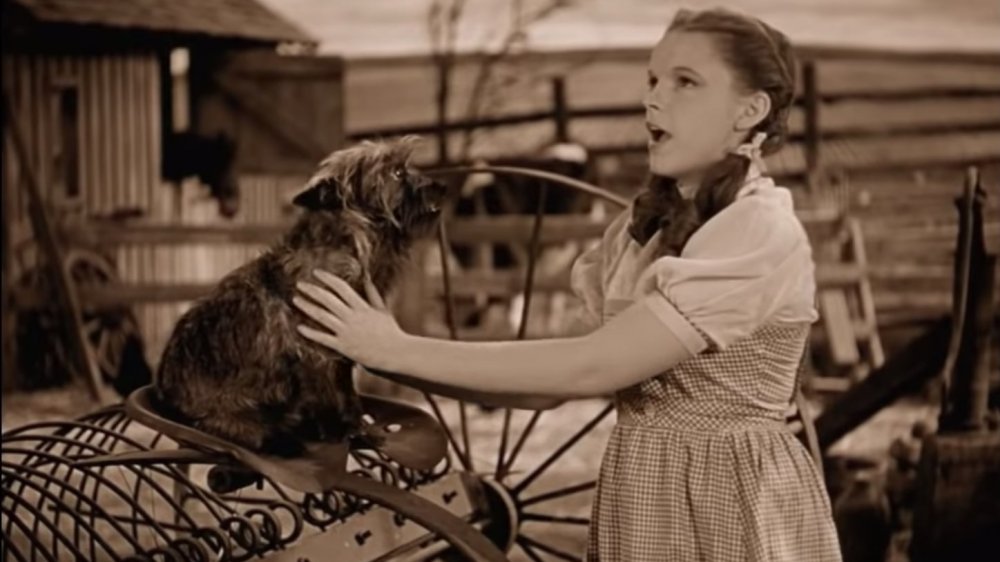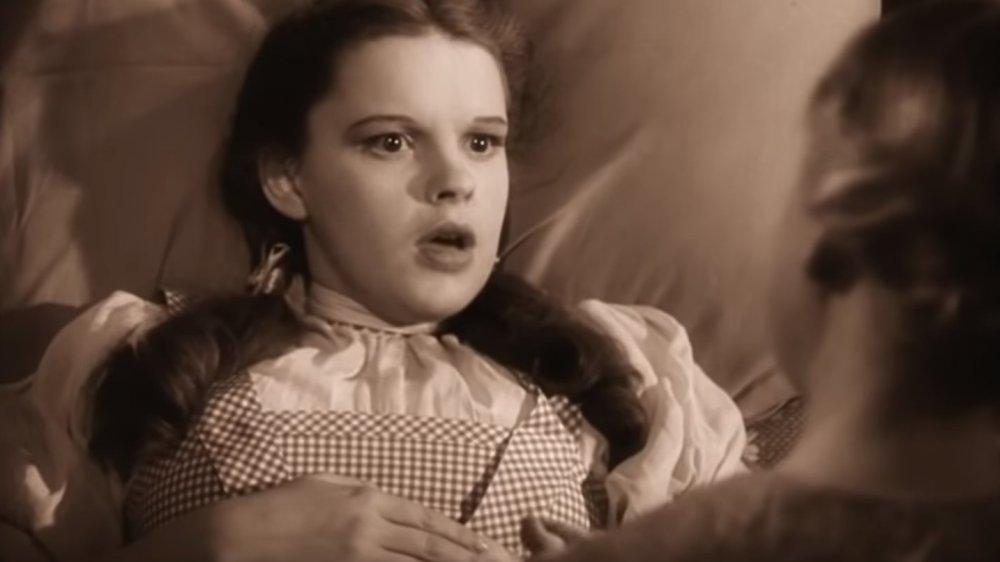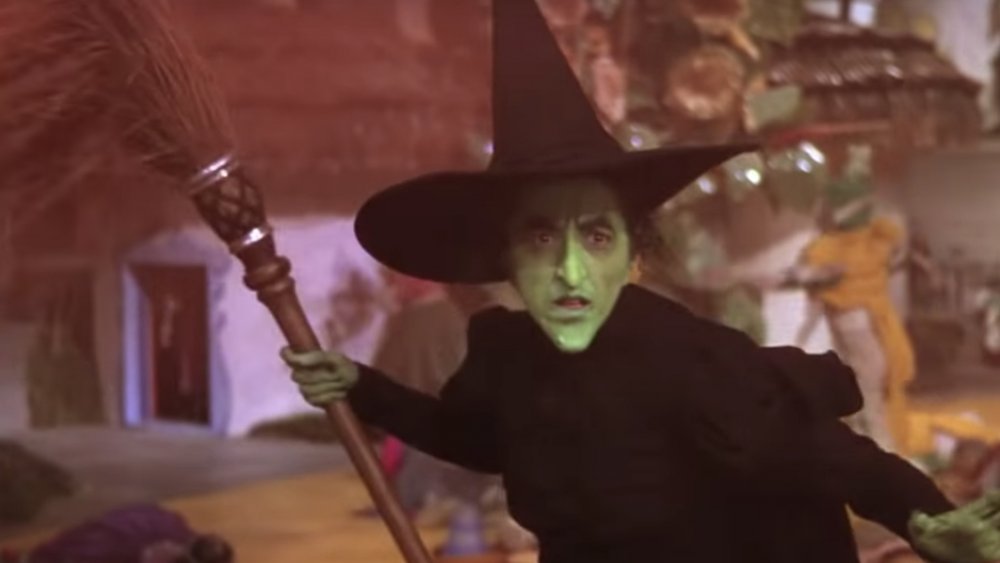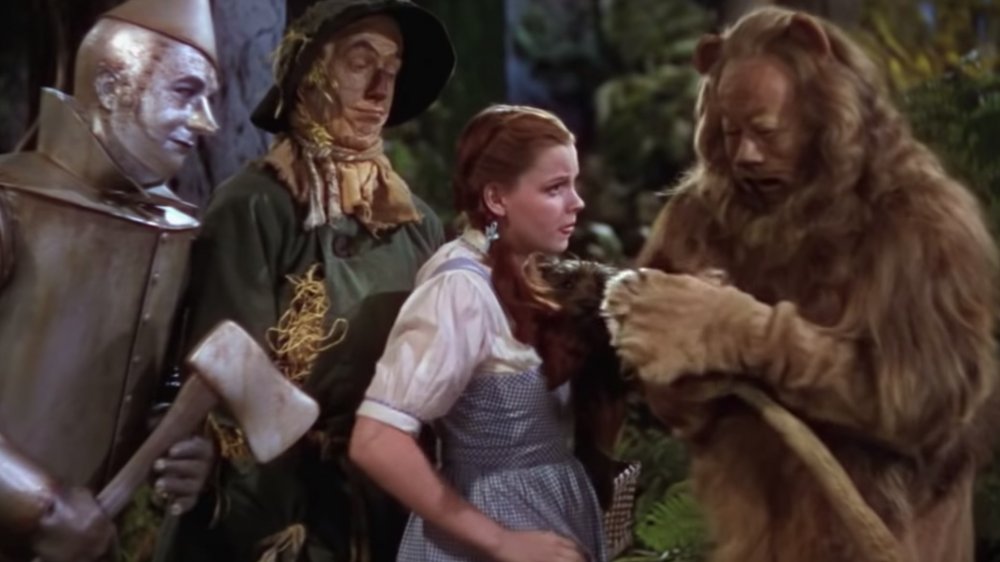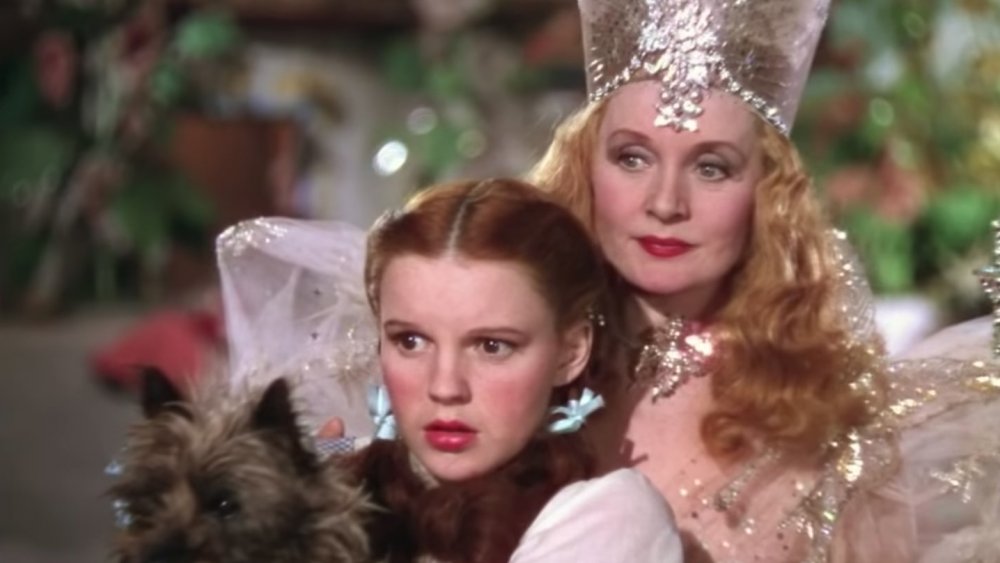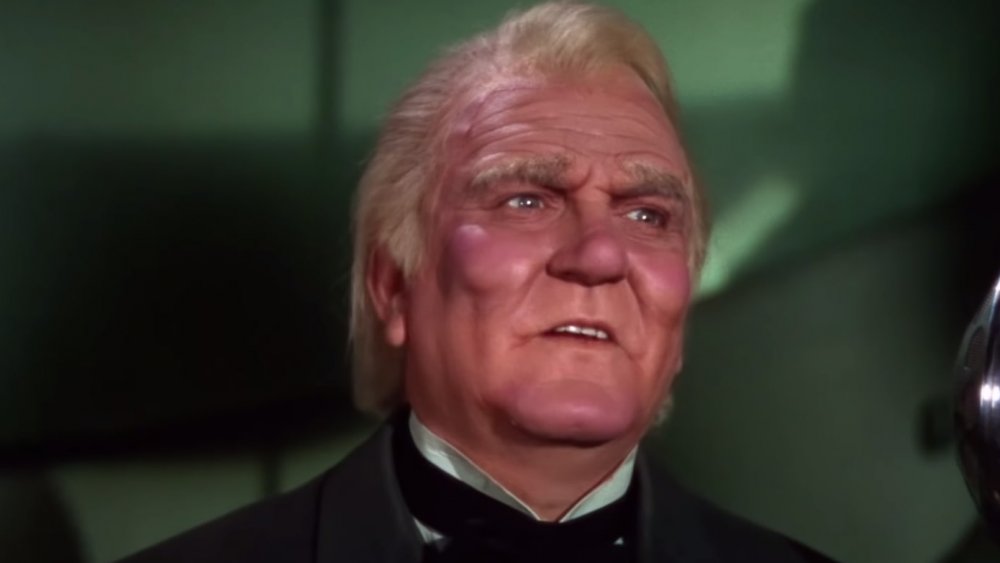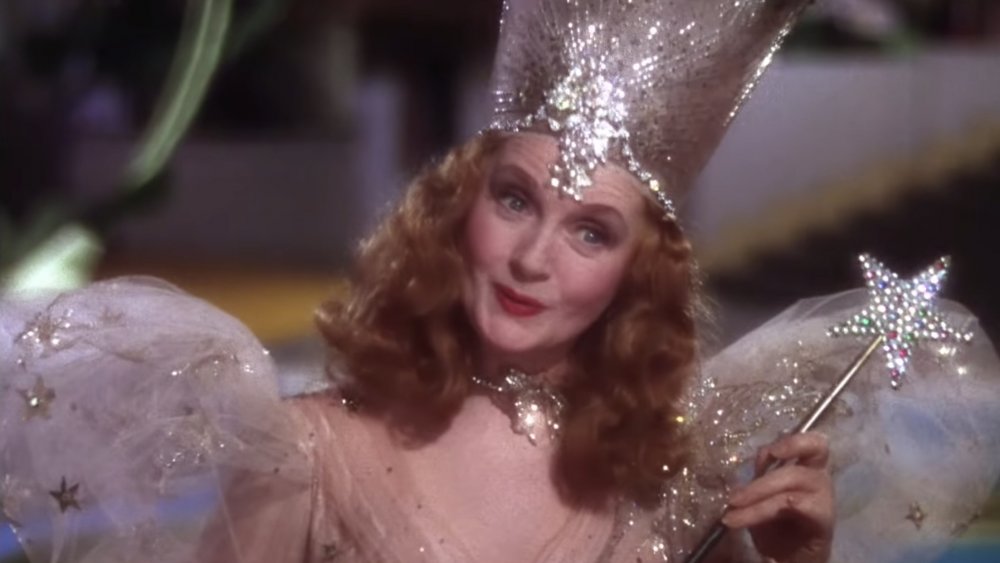The Wizard Of Oz: Things Only Adults Notice In The Classic Movie
Metro-Goldwyn-Mayer's The Wizard of Oz is the most influential film of all time, according to a group of researchers from the University of Turin (via Vanity Fair). Considering The Wizard of Oz, which was adapted from the children's novel written by L. Frank Baum and published in 1900, made its theatrical debut in 1939, the film's continued relevance in today's popular culture is quite an impressive feat.
That said, the fact that The Wizard of Oz still resonates with audiences isn't exactly surprising. After all, the film's overarching themes of seeing the good in every person, appreciating what you have, and learning to bloom where you're planted are essentially timeless. However, there's more to this technicolor fantasy film than what meets the eye.
While The Wizard of Oz is commonly viewed as a cinematic childhood staple, the story of Dorothy Gale trying to find her way back to Kansas is one that resonates with all ages. And, if you're like us, rewatching The Wizard of Oz as an adult will likely leave you seeing Dorothy and friends in a whole new light. Here's a look at things only adults notice in The Wizard of Oz.
The Wicked Witch of the West is right to be upset in The Wizard of Oz
In 2007, Time listed The Wizard of Oz's Wicked Witch of the West as one of cinema's all-time greatest villains. According to the publication, the vengeful witch (played to perfection by Margaret Hamilton) was "an out-of-the-closet sadist."
There's no doubt that the Wicked Witch of the West is a quintessential villain, with her evil grin, green skin, and unmistakable cackle. However, as an adult, it's hard to blame the Wicked Witch of the West for being, well, wicked. After all, her sister (aptly called the Wicked Witch of the East) had just been killed in a tragic accident involving a flying farmhouse from Kansas and an unfortunate instance of being in the wrong place at the wrong time.
As if that wasn't heartbreaking enough, when the Wicked Witch of the West came to the scene of the fatal accident to collect her sister's belongings (her ruby slippers), Glinda the Good Witch took the shoes from the dead witch's feet and gifted them to the girl who caused her death in the first place! Yeah, we'd be angry, too.
Why is there no Good Witch of the South in The Wizard of Oz?
Dorothy Gale is one of cinema's most memorable characters. And, of course, The Wizard of Oz would be nothing without Dorothy's beloved BFFs — the Scarecrow, the Tin Man, and the Cowardly Lion. In addition to Dorothy and her gang, viewers are introduced to three witches throughout the course of the film — Glinda (a.k.a. the Good Witch of the North), the Wicked Witch of the West, and the Wicked Witch of the East (may her wicked soul rest in peace). However, as adults, we can't help but notice that one directionally named witch is mysteriously missing. Whatever happened to the Good Witch of the South?
In L. Frank Baum's children's novel The Wonderful Wizard of Oz, the Good Witch of the North is the one who greets Dorothy when her house lands in Oz. According to The Atlantic, Glinda the Good Witch comes from the South, and she doesn't even make an appearance until the second-to-last chapter when Dorothy seeks her help to return home. Perhaps the film adaptation combined the Good Witches to streamline the storytelling process?
The Wizard of Oz's Dorothy Gale is a feminist hero
Throughout her quest in The Wizard of Oz, Dorothy Gale makes friends with a brainless scarecrow, a heartless tin man, and a cowardly lion — all of whom curiously resemble the three farmhands who work for her Auntie Em and Uncle Henry back in Kansas.
While Dorothy is often shown in distress throughout the movie, she's far from the stereotypical typical "damsel in distress" character. Her three male cohorts do help her escape from the Wicked Witch's castle toward the end of the film, but it's Dorothy who ultimately saves the Scarecrow's life, kills the evil witch, and bravely confronts the most powerful man in all of Oz when he tries to take advantage of her and her trusting, good-natured friends. According to The New York Times, L. Frank Baum, author of The Wonderful Wizard of Oz, was a feminist, once writing in a newspaper editorial that men who did not support feminist aspirations were "selfish, opinionated, conceited or unjust — and perhaps all four combined."
Considering Dorothy was the brainchild of a feminist ally, it makes sense that she ultimately became the hero of her own story.
Is The Wizard of Oz a study in imposter syndrome?
Defined by Harvard Business Review as "a collection of feelings of inadequacy that persist despite evident success," imposter syndrome is a seed of self-doubt that, when planted in your mind, can have you feeling like a Scooby-Doo villain just waiting to be unmasked by those meddling kids.
The titular wizard in The Wizard of Oz is a personified example of an imposter syndrome sufferer's worst nightmare. After the Wizard of Oz lives years posing as a powerful, disembodied being, Toto pulls back the curtain to expose the Wizard for who he truly is — a lowly "humbug." Once exposed, the fake wizard admits he's just a man from Kansas who accepted the gig as Wizard of Oz after being swept away from his home by a cyclone.
However, despite being a humbug, he is able to help Dorothy's pals by gifting them with the realization that the things they were searching for (heart, brains, and courage) have been within them all along. In doing so, he proves that he is, in fact, great and powerful in his ability to help others — no curtain or special effects required.
A dream within a dream within The Wizard of Oz
In an attempt to prevent Dorothy and her friends from entering the Emerald City and gaining access to the great and powerful Wizard of Oz, the Wicked Witch of the West conjures up an obstacle as dangerous as it is beautiful — a field of poppies. Poppies, of course, are famously known for being a source of opium, which was once commonly used for pain relief and sleep aid. Upon entering the field of flowers, Dorothy and the Cowardly Lion are both lulled into a deep sleep by the poppies, much to the Wicked Witch of the West's delight.
As we know, The Wizard of Oz ends with Dorothy waking up in her bed and realizing her adventures in Oz were all part of a dream she had after being knocked unconscious during the tornado. With that in mind, it's interesting that Dorothy's unconscious brain was able to imagine falling into a deep, dreamlike state while already very much in an actual deep, dreamlike state. Inception, anyone?
What happened to Dorothy's parents in The Wizard of Oz?
Dorothy Gale's sepia-tone life as a farm girl — a stark contrast to the technicolor adventureland of Oz — is introduced to viewers early on in The Wizard of Oz, as are Dorothy's guardians, Auntie Em and Uncle Henry. The film does a thorough job of welcoming its audience into the seemingly dull, small-town life that leaves Dorothy yearning for a "land that [she'd] heard of once in a lullaby." However, it doesn't even begin to scratch the surface of Dorothy's backstory — namely, the circumstances that led to her living with her aunt and uncle.
Though Dorothy never once mentions her biological parents, we can't help but wonder why they're no longer around. Fortunately, Dorothy doesn't seem too upset by their absence, leaving viewers to assume that living with Auntie Em and Uncle Henry isn't a new development in our heroine's life.
However, while the movie avoids the topic of Dorothy's parents entirely, L. Frank Baum's The Wonderful Wizard of Oz refers to her as an orphan, meaning Dorothy's mom and dad likely didn't leave of their own volition.
What kind of message is The Wizard of Oz really sending to kids?
Arguably the most famous quote from The Wizard of Oz is Dorothy's line, "There's no place like home." However, as adults, this sentimental quip feels more like an anti-exploration PSA.
Before she leaves Oz for Kansas, the Tin Man asks Dorothy what she's learned, to which she replies, "If I ever go looking for my heart's desire again, I won't look any further than my own backyard. Because, if it isn't there, I never really lost it to begin with." When she finally wakes up in the comfort of her own bed, Dorothy says, "I'm not going to leave here ever, ever again, because I love you all!" She continues, exclaiming, "Oh, Auntie Em, there's no place like home!"
We love home as much as the next person, but it certainly seems that the overarching takeaway from The Wizard of Oz was meant to discourage young people from adventuring any further from their own backyards. Sorry, Dorothy, but that's not a message we can get behind.
The Wizard of Oz's Toto should have been on a leash
Even the most well-behaved dogs can act up once in a while. And, unless you and your loyal companion are visiting a place specifically designed for off-leash dogs, it's probably best to utilize a leash — just in case your predictable pup springs for a moment of spontaneity.
One thing's for certain: Toto, Dorothy's adorable pooch in The Wizard of Oz, definitely could have benefited from a leash. Though undeniably cute, Toto proves himself to be a bit of a troublemaker in the film's very first scene.
The Wizard of Oz opens with a shot of Toto running on a dirt path alongside a concerned-looking Dorothy. Why is Dorothy worried, you ask? Well, as Dorothy reveals, Toto has just snapped and bit Almira Gulch (the Kansas counterpart of the Wicked Witch of the West). Later, Miss Gulch arrives at Auntie Em and Uncle Henry's house demanding to have Toto put to sleep for what he did. Luckily, the little pup was able to escape — but a simple leash for Toto likely would have saved Dorothy some tears.
How long was The Wizard of Oz's Dorothy actually unconscious?
The Wizard of Oz has a runtime of 1 hour and 42 minutes, according to IMDb, but, of course, Dorothy spent more than two hours in the magical land of Oz. Exactly how long was she there?
When Dorothy wakes up in her bedroom after being knocked unconscious during the cyclone, Uncle Henry tells Professor Marvel, "She got quite a bump on the head. We kind of thought there for a minute she was gonna leave us." Upon hearing this, Dorothy replies, "But I did leave you, Uncle Henry. That's just the trouble!" She continues, exclaiming, "And I tried to get back for days and days!"
Apparently, time works differently in Oz. While Dorothy might have spent "days and days" trying to find her way back home, it seems that only a few hours have passed in Kansas. After all, Auntie Em, Uncle Henry, Professor Marvel, and Dorothy's farmhand friends are dressed in the same clothes they were wearing before the cyclone hit.
The Wizard of Oz's Wicked Witch of the West must not bathe
When the Wicked Witch of the West uses her flying broomstick to set fire to the Scarecrow toward the end of the film, Dorothy acts fast, grabbing a bucket of rainwater and tossing it on her friend to extinguish the flames. However, a bit of water also splashes the Wicked Witch's face, causing her to melt.
As she's melting, the witch screeches, "What a world, what a world! Who would have thought a good little girl like you could destroy my beautiful wickedness?"
Maybe we're overthinking the logistics here, but, as adults rewatching The Wizard of Oz, we think a better question would be, "Who would have thought a little bit of water could kill the Wicked Witch of the West?" If such a small splash was able to cause a full-on, literal meltdown, are we to believe that the Wicked Witch never washed her hands, took a bath, or got caught in an unexpected rainstorm? Was she even able to drink water? We're willing to suspend our disbelief for a lot of things, but we'd love an explanation here.
Dorothy's dress in the Wizard of Oz has pockets!
If you're a woman, you're all too familiar with the struggle of trying to find clothing with actual pockets. As Tanya Basu explained in a piece for The Atlantic, "Women's slacks, dresses, and blazers often have no pockets, or worse, 'fake' pockets that serve no utilitarian purpose besides sartorially leading the wearer on to believe they have a handy wardrobe aide, until it's too late."
The pocket problem is a real and pressing issue for us women — so, when we do come across a cute dress with pockets, we want to shout our excitement from the rooftops. With that in mind, imagine our excitement upon spotting a pocket on Dorothy's famous blue and white gingham dress.
Blink and you'll miss it, but Dorothy can be seen pulling a handkerchief from the discreet pocket while trying to comfort the crying Cowardly Lion during their first encounter. According to NBC News, this secret pocket was sewn into a seam so that actress Judy Garland would have a convenient place to keep her cigarettes.
Who does Glinda the Good Witch represent in The Wizard of Oz?
Glinda the Good Witch is a major player in The Wizard of Oz. She's the one who puts the ruby slippers on Dorothy's feet when the Kansas girl first arrives in Oz, the one who wakes Dorothy and the Cowardly Lion from their poppy-induced sleep, and the one who ultimately helps Dorothy get back to Auntie Em and Uncle Henry by reminding her there's no place like home.
However, Glinda doesn't appear to have a real-life counterpart, unlike the other main characters Dorothy meets in Oz. The Wicked Witch of the West, for example, is the Oz equivalent of Almira Gulch, while the Scarecrow, Tin Man, and Cowardly Lion are all representative of Dorothy's farmhand friends. Even Professor Marvel is part of Dorothy's technicolor dream as none other than the Wizard of Oz himself.
It would make sense for the Good Witch of the North to have been inspired by a real person from Dorothy's hum-drum, sepia-tone world. However, if there is a Glinda-like character in Dorothy's real life, she's never shown on screen.
Is the Wizard of Oz supposed to be like a politician?
While rewatching The Wizard of Oz, you'll likely find it difficult to ignore the film's political symbolism. A glaring example of this comes when the Wizard of Oz attempts to abandon his promise to help Dorothy and her pals, prompting Toto to pull back the curtain to expose the so-called wizard for who he truly is.
"Oh, you're a very bad man," Dorothy says upon realizing the great and powerful Wizard of Oz is actually not a wizard at all. "No, my dear, I'm a very good man," the wannabe wizard replies. "I'm just a very bad wizard."
You don't have to know a lot about politics to know that many politicians never fully make good on the promises they make to voters. Of course, this doesn't necessarily mean said politicians are bad people; however, it could mean they're simply not cut out for leadership positions within the world of politics. Considering the Wizard of Oz ultimately proves himself to be a generous, kindhearted man, it's safe to say he's far from a stereotypical, morally corrupt politician type. However, as he said himself, he's still a very bad wizard.
The Wizard of Oz's Glinda the Good Witch is a bit of a drama queen
Rewatching The Wizard of Oz as adults has us thinking that Glinda the Good Witch might not be as altruistic of a character as we were made to believe as children.
For starters, the fact that Glinda allows Dorothy to repeatedly put herself and her pals in harm's way while trying to find her way back to Kansas — all while wearing a pair of teleportation devices on her feet — is incredibly bewildering. When the Scarecrow asks Glinda why she didn't tell Dorothy that she'd possessed the power to get back to Kansas all along, the Good Witch of the North responds, "Because she wouldn't have believed me. She had to learn it for herself."
Considering Dorothy believed everything else Glinda said upon her arrival in Oz, we're almost certain she would have trusted that clicking the ruby slippers together would get her back to Auntie Em and Uncle Henry. Maybe we're reading too far into things, but it seems to us that Glinda is just a sucker for some good old-fashioned manufactured drama.
